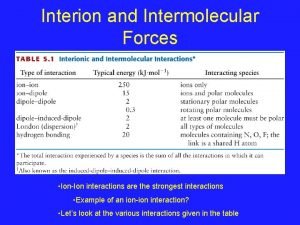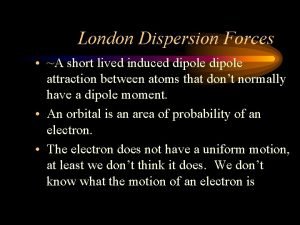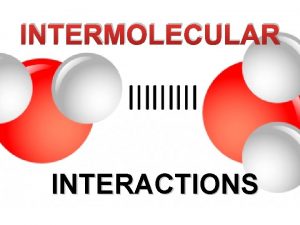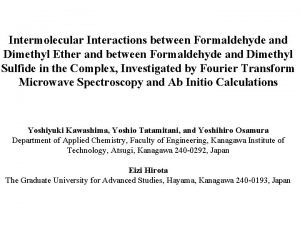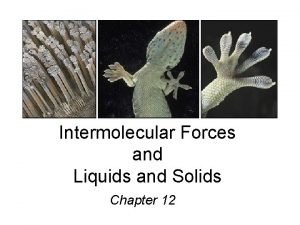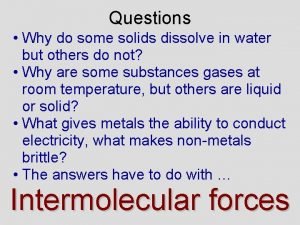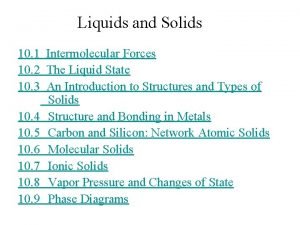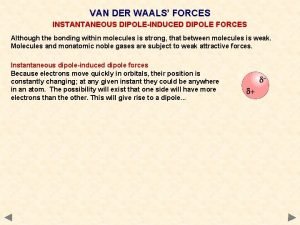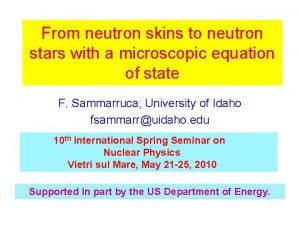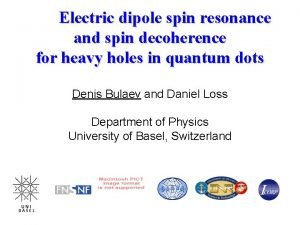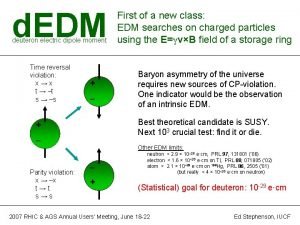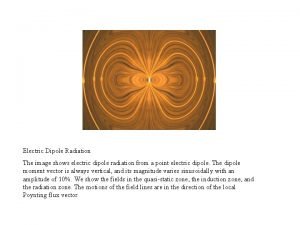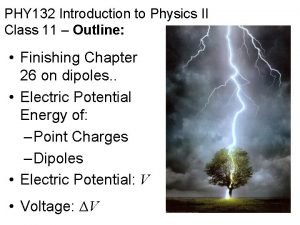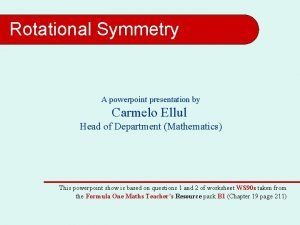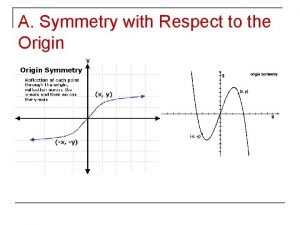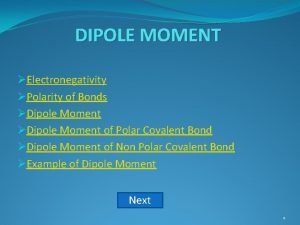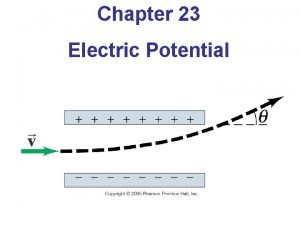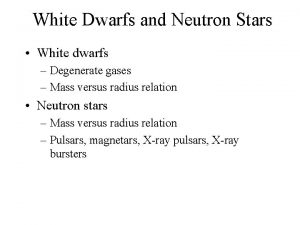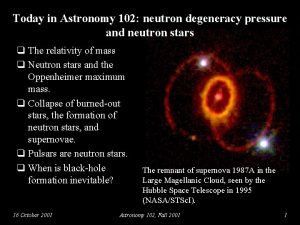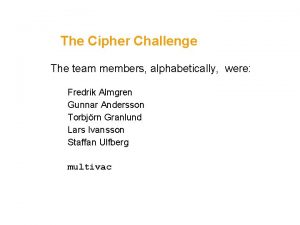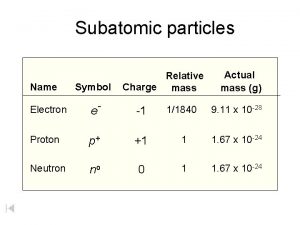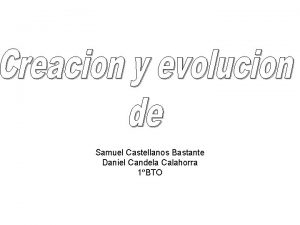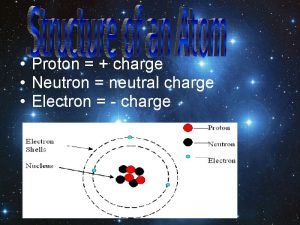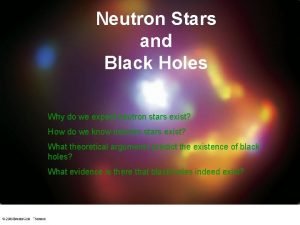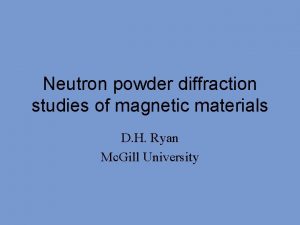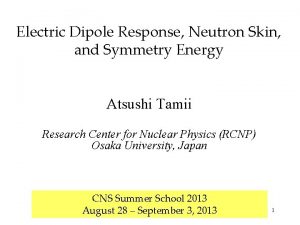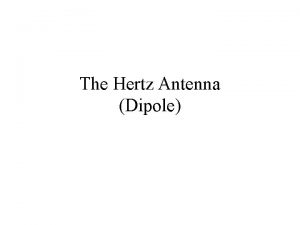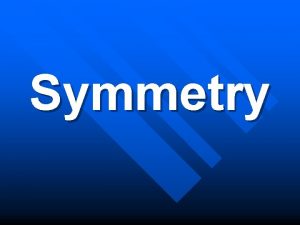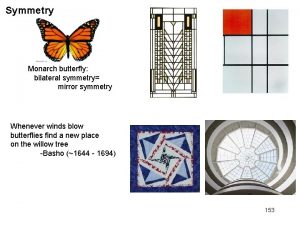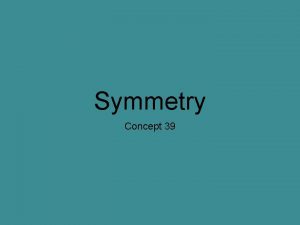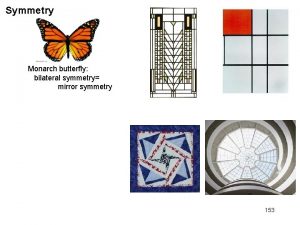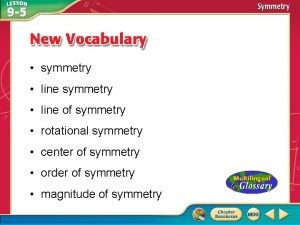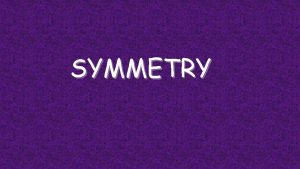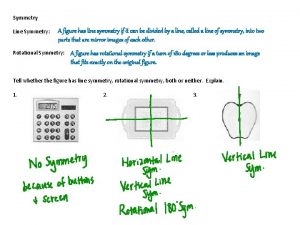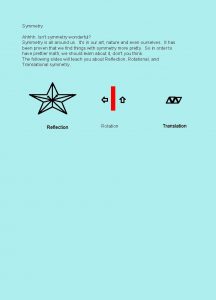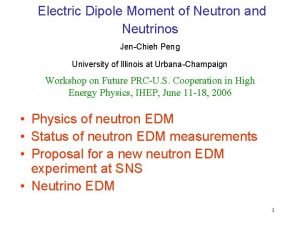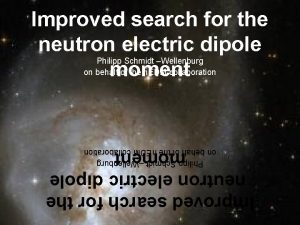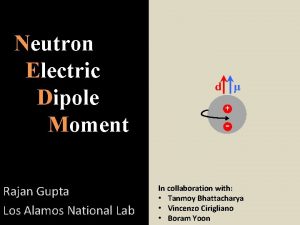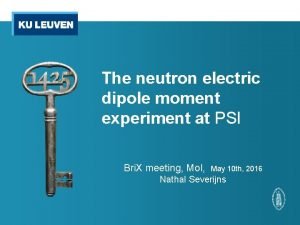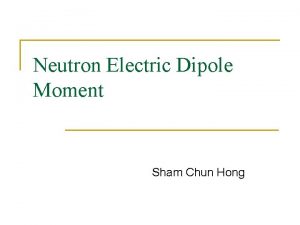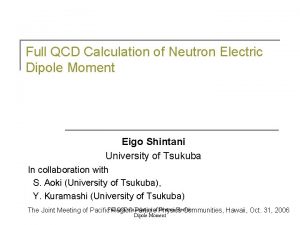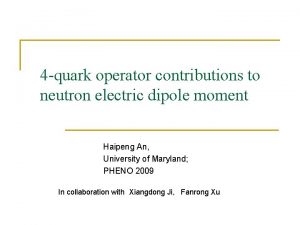Electric Dipole Response Neutron Skin and Symmetry Energy









![Charge Density (Electron Scattering) [1] B. Frois et al, PRL 38, 152(1977) charge radius: Charge Density (Electron Scattering) [1] B. Frois et al, PRL 38, 152(1977) charge radius:](https://slidetodoc.com/presentation_image_h2/b9e98c9ca9efd888df63f67ad1beb101/image-10.jpg)

![Parity Violating (PV) Cross Section Asymmetry in Electron Scattering [8] 2 + 208 Pb Parity Violating (PV) Cross Section Asymmetry in Electron Scattering [8] 2 + 208 Pb](https://slidetodoc.com/presentation_image_h2/b9e98c9ca9efd888df63f67ad1beb101/image-12.jpg)












































- Slides: 56

Electric Dipole Response, Neutron Skin, and Symmetry Energy (II) Atsushi Tamii Research Center for Nuclear Physics (RCNP) Osaka University, Japan CNS Summer School 2013 August 28 – September 3, 2013 1

Outline of the lecture 1. Symmetry energy • mass formula • nuclear density distribution • nuclear equation of state (EOS) 2. Determination the neutron skin thickness and the symmetry energy by using • weak interaction • strong interaction • electro-magnetic interaction

E/A (Me. V) Neutron Matter (d=1) 核子当たりのエネルギー E/N (Me. V) Nuclear Equation of State (EOS) Neutron Density (fm-3) Neutron Matter (d=1) Symmetry Energy (and Coulomb) Nuclear Matter (d=0) Nucleon Density (fm-3) Steiner et al. , Phys. Rep. 411 325(2005) Prediction of the neutron matter EOS is much model dependent.

Type II Supernova Langanke and Martinez-Pinedo Supernova Cycle

Determination of the Symmetry Energy Term in EOS. Neutron Star Mass and Radius Core-Collapse Supernova K. Sumiyoshi, Astrophys. J. 629, 922 (2005) Nucleosynthesis Langanke and Martinez-Pinedo Neutron Star Cooling Lattimer et al. , Phys. Rep. 442, 109(2007) Neutron Star Structure Accreting neutron star/white dwarf, X-Ray burst, Superburst http: //www. astro. umd. edu/~miller/nstar. html

Neutron Star Fundamental Questions: How large and how stiff is a neutron star? What is the inner structure? How much content of protons and electrons? Do meson-condensed states or hyperons exist? For answering to the questions, precise knowledge is required for the EOS of nuclear and neutron rich matter. http: //www. astro. umd. edu/~miller/nstar. html

Nuclear Equation of State (EOS) EOS for Energy per nucleon Saturation Density ~0. 16 fm-3 Symmetry energy Determination of L is becoming important. L: Slope Parameter (Baryonic Pressure)

Neutron Skin and the Density Dependence of the X. Roca-Maza et al. , PRL 106, 252501 (2011) Symmetry Energy Density distribution of protons and neutrons in a nucleus Neutron density Proton density Neutron skin thickness Neutron rms radius Proton rms radius Density dependence of the symmetry energy

Experimental Methods Symmetry Energy • Nuclear mass formula • Neutron skin thickness • Heavy Ion Collision • Isobaric analogue state energy • Neutron-star observation • … Neutron Skin Thickness • Parity-violating electron elastic scattering • Proton elastic scattering • Electric dipole polarizability • Giant dipole resonance • Pygmy dipole resonance • Spin dipole resonance • Anti-protonic atom X-ray • … 208 Pb Anti-analogue GDR of 208 Pb: talk by J. Yasuda PDR in Sn isotopes: talk by P. Schrock Posters by Nakatsuka, D. T. Khoa, …
![Charge Density Electron Scattering 1 B Frois et al PRL 38 1521977 charge radius Charge Density (Electron Scattering) [1] B. Frois et al, PRL 38, 152(1977) charge radius:](https://slidetodoc.com/presentation_image_h2/b9e98c9ca9efd888df63f67ad1beb101/image-10.jpg)
Charge Density (Electron Scattering) [1] B. Frois et al, PRL 38, 152(1977) charge radius: 5. 50 fm point proton radius: 5. 45 fm (by using formula in [41]) 10

Outline of the lecture 1. Symmetry energy • mass formula • nuclear density distribution • nuclear equation of state (EOS) 2. Determination the neutron skin thickness and the symmetry energy by using • weak interaction at J-Lab • strong interaction at RCNP • electro-magnetic interaction at RCNP
![Parity Violating PV Cross Section Asymmetry in Electron Scattering 8 2 208 Pb Parity Violating (PV) Cross Section Asymmetry in Electron Scattering [8] 2 + 208 Pb](https://slidetodoc.com/presentation_image_h2/b9e98c9ca9efd888df63f67ad1beb101/image-12.jpg)
Parity Violating (PV) Cross Section Asymmetry in Electron Scattering [8] 2 + 208 Pb Pb APV from interference in PWBA R (L): Right (Left) helicity longitudinal polarization GF: Fermi coupling constant α: fine structure constant Q: four-momentum transfer (ω, q) FW: weak form factor Fch: charge form factor 208 Pb page-2 ϑ ϑ interference between EM and weak interactions Fourier transform of the weak charge density Coulomb distortion effect is included in the real analysis [9], also other effects [10]. R L e e helicity 12

Weak Charge J-F. Rajotte, arxiv: 1110. 2218 v 1 in the standard model ~ 0. 08 ϑw: Weinberg Angle or Weak Mixing Angle 0. 0721 -0. 9878 with radiative correction sin 2 ϑw=0. 23116(12) c. f. PDG 2012 Weak charge distribution is primarily determined by the neutron distribution BUT weak interaction is VERY weak. . . APV ~ 656 ppb = 0. 000000656 13

Hall A at Jefferson Lab Hall A B C

Neutron Skin Thickness Measurement by Electroweak Interaction PREX at J-Lab: Z 0 of weak interaction : sees the neutrons p n Electric charge 1 0 Weak charge 0. 08 1 Parity Violating Asymmetry C. J. Horowitz S. Abrahamyan et al. , PRL 108, 112502 (2012) Model independent determination of the neutron skin thickness

Neutron Skin Thickness Measurement by Electroweak Interaction PREX Result: S. Abrahamyan et al. , PRL 108, 112502 (2012) Theor. Calc. : X. Roca-Maza et al. , PRL 106, 252501 (2011) The model independent determination of d. Rnp by PREX is quite important but the present accuracy is limited.

Outline of the lecture 1. Symmetry energy • mass formula • nuclear density distribution • nuclear equation of state (EOS) 2. Determination the neutron skin thickness and the symmetry energy by using • weak interaction at J-Lab • strong interaction at RCNP • electro-magnetic interaction at RCNP

Determination of Neutron Density Distribution by Strong Interaction Polarized proton elastic scattering at 295 Me. V (RCNP, Osaka University) Analysis with relativistic impulse approximation (RIA), medium modification fixed with 58 Ni data ds/d. W, Ay rn(r) RIA + Medium Effect J. Zenihiro et al. , PRC 82, 044611 (2010) Rn-Rp=0. 211 Drn/rn < 0. 5% fm

Medium modification of RLF NN interaction Medium effect à Phenomenological parameters; aj, bj à Universal form of density-dependent terms à At r=0, same as free NN interaction Need to calibrate with real data H. Sakaguchi et al. , PRC 57, 1749.

X. Roca-Maza et al. , PRL 106, 252501 (2011)

Outline of the lecture 1. Symmetry energy • mass formula • nuclear density distribution • nuclear equation of state (EOS) 2. Determination the neutron skin thickness and the symmetry energy by using • weak interaction at J-Lab • strong interaction at RCNP • electro-magnetic interaction at RCNP

Neutron Skin Thickness Measurement by Electromagnetic Interaction Covariance analysis of energy density functional calculations with Skrym SV-min effective interaction. P. -G. Reinhard and W. Nazarewicz, PRC 81, 051303(R) (2010). Strong correlation between the (electric) dipole polarizability and the neutron skin of 208 Pb

(Electric) Dipole Polarizability P: electric dipole moment a: electric dipole polarizability Inversely energy weighted sum-rule of B(E 1)

(Electric) Dipole Polarizability balanced E 1 -field restoring force symmetry energy

(Electric) Dipole Polarizability with neutron skin smaller restoring force w/o neutron skin larger restoring force

(Electric) Dipole Polarizability thicker neutron skin smaller restoring force larger displacement with neutron skin smaller restoring force w/o neutron skin larger restoring forcelarger dipole polarizability

(Electric) Dipole Polarizability with neutron skin smaller restoring force w/o neutron skin larger restoring force

(Electric) Dipole Polarizability P: electric dipole moment a: electric dipole polarizability Inversely energy weighted sum-rule of B(E 1)

Electric Dipole (E 1) Response Particle (neutron) separation energy oscillation of neutron skin against core? E 1 1 - Low-Lying Dipole Strength g. s. 0 Sn Sp oscillation between neutrons and protons core neutron skin (PDR) GDR

Probing EM response of the target nucleus Real Photon Measurements, NRF and (g, xn) Decay g-rays or neutrons are measured. Target Nucleus Excited State Missing Mass Spectroscopy with Virtual Photon Insensitive to the decay channel. Total strengths are measured. Select low momentum transfer (q~0) kinematical condition, i. e. at zero degrees q, w Target Nucleus Only the scattered protons are measured. Excited State Coulomb Excitation at 0 deg. EM Interaction is well known (model independent)

Research Center for Nuclear Physics, Osaka Univ. High-resolution Spectrometer Grand Raiden High-resolution WS beam-line (dispersion matching)

Spectrometers in the 0 -deg. experiment setup AT et al. , NIMA 605, 326 (2009) As a beam spot monitor in the vertical direction Focal Plane Polarimeter 208 Pb target: 5. 2 mg/cm 2 Dispersion Matching Intensity : 1 -8 n. A Polarized Proton Beam at 295 Me. V

Setup for E 282&E 316


B(E 1): low-lying discrete states Excellent agreement between (p, p’) and (g, g’) below ~Sn I. Poltoratska, Ph. D thesis

B(E 1): continuum and GDR region Method 1: Multipole Decomposition Neglect of data for Q>4: (p, p´) response too complex Included E 1/M 1/E 2 or E 1/M 1/E 3 (little difference)

B(E 1): continuum and GDR region Method 2: Decomposition by Spin Observables Polarization observables at 0° E 1 and M 1 decomposition spinflip / non-spinflip separation model-independent T. Suzuki, PTP 103 (2000) 859 M 1 E 1

E 1 Response of 208 Pb and a. D combined data The B(E 1) distribution and dipole polarizability of 208 Pb has been precisely determined. AT et al. , PRL 107, 062502(2011)

Correlation Between Dipole Polarizability and Neutron Skin Thickness J. Piekarewicz et al. , PRC 85, 041302(2012)

Correlation Between Dipole Polarizability and Neutron Skin Thickness Theoretical models can be much constrained if precise data on the neutron skin thickness is also available (but not).

Correlation Between Dipole Polarizability and Neutron Skin Thickness

Neutron Skin Thickness Measurement by Electromagnetic Interaction PES: Proton Elastic Scattering, Zenihiro et al. , PRC.

DP: Dipole Polarizability L=46± 15 Me. V Based on the work by X. Roca-Maza et al. , PRL 106, 252501 (2011)

X. Roca-Maza et al. , ar. Xiv: 1307. 4806 a. D J is a strong isovector indicator. Insights from the droplet model Talk by X. Roca-Maza (next session)

X. Roca-Maza et al. , ar. Xiv: 1307. 4806 It would be better to use the correlation between a. D J and L (or Dnp) than use the correlation between a. D and L (or Dnp) to extract constraints. We have used the correlation between a. D J and L (gray band in the right figure) to extract a constraint band in the J-L plane.

Constraints on J and L M. B. Tsang et al. , PRC 86, 015803 (2012). I. Tews et al. , PRL 110, 032504 (2013) DP: Dipole Polarizability HIC: Heavy Ion Collision PDR: Pygmy Dipole Resonance IAS: Isobaric Analogue State FRDM: Finite Range Droplet Model (nuclear mass analysis) n-star: Neutron Star Observation c. EFT: Chiral Effective Field Theory

Constraints on J and L M. B. Tsang et al. , PRC 86, 015803 (2012). I. Tews et al. , PRL 110, 032504 (2013) DP: Dipole Polarizability HIC: Heavy Ion Collision PDR: Pygmy Dipole Resonance IAS: Isobaric Analogue State FRDM: Finite Range Droplet Model (nuclear mass analysis) n-star: Neutron Star Observation c. EFT: Chiral Effective Field Theory DP: + theoretical uncertainty

Constraints on J and L M. B. Tsang et al. , PRC 86, 015803 (2012). I. Tews et al. , PRL 110, 032504 (2013) DP: Dipole Polarizability HIC: Heavy Ion Collision PDR: Pygmy Dipole Resonance IAS: Isobaric Analogue State FRDM: Finite Range Droplet Model (nuclear mass analysis) n-star: Neutron Star Observation c. EFT: Chiral Effective Field Theory QMC by S. Gandolfi et al. , DP: + theoretical uncertainty

QMC “The concordance of experimental, theoretical and observational analyses suggests that neutron star radii, in the mass range 1 M -2 M , lie in the narrow window 11 km < R < 12 km. ” Lattimer et al. , ar. Xiv 1203. 4286 v 1(2012)

Sun 1 M 110 times larger than the earth Earth

Size of a Neutron Star (R~12 km) (1. 4 M ) RIKEN Neutron star

Size of a Neutron Star (R~12 km) (1. 4 M ) 208 Pb nucleus R ~ 6 fm Neutron star R ~ 12 km

Summary of the part 2 I have discussed l experimental attempts to determine the neutron skin thickness of 208 Pb by measuring • parity-violating electron scattering (weak int. ) • proton elastic scattering (strong int. ) • 3 dipole polarizability (EM int. ) l present constraints on the symmetry energy parameters J and L.

Summary • The electric dipole response of 208 Pb has been precisely measured by using proton inelastic scattering as an electro magnetic probe. as a. D=20. 1± 0. 6 fm 3/e 2 • A lot of data under analysis: 96 Mo (DCS and PT): D. Martin 48 Ca (DCS): J. Birkhan 90 Zr (DCS): C. Iwamoto (PDR-region, published in PRL 108, 262501 (2012)) 120 Sn (DCS and PT): A. M. Krumbholtz, T. Hashimoto 154 Sm (DCS and PT): A. Krugmann 88 Sr, 92 Mo (DCS): C. Iwamoto 70 Zn (DCS):

Collaborators RCNP-E 282 RCNP, Osaka University A. Tamii, H. Matsubara, H. Fujita, K. Hatanaka, H. Sakaguchi Y. Tameshige, M. Yosoi and J. Zenihiro IKP, TU-Darmstadt P. von Neumann-Cosel, A-M. Heilmann, Y. Kalmykov, I. Poltoratska, V. Yu. Ponomarev, A. Richter and J. Wambach Dep. of Phys. , Osaka University Y. Fujita KVI, Univ. of Groningen T. Adachi and L. A. Popescu IFIC-CSIC, Univ. of Valencia B. Rubio and A. B. Perez-Cerdan Sch. of Science Univ. of Witwatersrand J. Carter and H. Fujita i. Themba LABS F. D. Smit Texas A&M Commerce C. A. Bertulani GSI CNS, Univ. of Tokyo K. Nakanishi, Y. Shimizu and Y. Sasamoto Dep. of Phys. , Kyoto University T. Kawabata CYRIC, Tohoku University M. Itoh and Y. Sakemi Dep. of Phys. , Kyushu University M. Dozono Dep. of Phys. , Niigata University 55 Y. Shimbara

Thank You
 Ion-dipole interaction example
Ion-dipole interaction example Induced dipole
Induced dipole Dipole dipole forces
Dipole dipole forces Dispersion forces vs dipole dipole
Dispersion forces vs dipole dipole Dipole induced dipole forces examples
Dipole induced dipole forces examples Formaldehyde intermolecular forces
Formaldehyde intermolecular forces Ion induced dipole example
Ion induced dipole example Surface tension intermolecular forces
Surface tension intermolecular forces Induced dipole
Induced dipole Dipole-dipole attractions
Dipole-dipole attractions Strength of intermolecular forces
Strength of intermolecular forces Intermolecular forces and vapor pressure
Intermolecular forces and vapor pressure Dipole dipole interaction
Dipole dipole interaction Van der waals forces
Van der waals forces Medan listrik dipol
Medan listrik dipol Neutron skin
Neutron skin Electric dipole moment
Electric dipole moment Electric dipole spin resonance
Electric dipole spin resonance Electric dipole
Electric dipole Potential energy due to point charge
Potential energy due to point charge The gaussian surface is
The gaussian surface is Electric dipole image
Electric dipole image Electric field lines
Electric field lines Thin skin vs thick skin
Thin skin vs thick skin Thin skin vs thick skin
Thin skin vs thick skin Basic facial steps milady
Basic facial steps milady Mastering physics
Mastering physics Electric field strength equation
Electric field strength equation Electric potential is
Electric potential is Chapter 21 electric charge and electric field
Chapter 21 electric charge and electric field Chapter 21 electric charge and electric field
Chapter 21 electric charge and electric field Coulombs units
Coulombs units Units of a charge
Units of a charge Electric charges and electric forces lesson outline
Electric charges and electric forces lesson outline Rotational symmetry powerpoint
Rotational symmetry powerpoint Natural response and forced response
Natural response and forced response Natural and forced response
Natural and forced response Primary immune response and secondary immune response
Primary immune response and secondary immune response Energy energy transfer and general energy analysis
Energy energy transfer and general energy analysis Energy energy transfer and general energy analysis
Energy energy transfer and general energy analysis A suitable electric pump in an electric circuit is a
A suitable electric pump in an electric circuit is a Which functions are symmetric with respect to the origin?
Which functions are symmetric with respect to the origin? Isis neutron and muon source
Isis neutron and muon source Dipole moment definition chemistry
Dipole moment definition chemistry V and e relation
V and e relation Unit of electric potential
Unit of electric potential Electric potential to work
Electric potential to work Joules to newtons
Joules to newtons Neutron degeneracy pressure
Neutron degeneracy pressure Neutron degeneracy pressure definition
Neutron degeneracy pressure definition Cipher neutron
Cipher neutron Symbol for relative
Symbol for relative Candela y neutron
Candela y neutron Charge of a neutron
Charge of a neutron How are neutrons formed
How are neutrons formed 642008419
642008419 Number of protons in gold
Number of protons in gold
